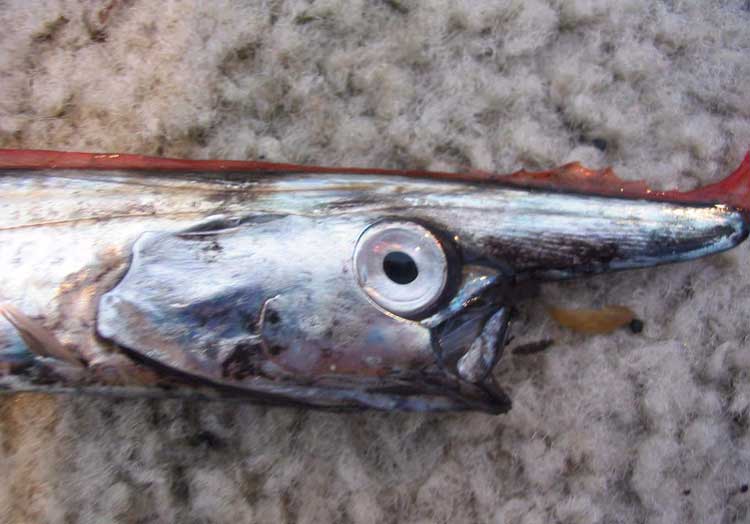Eumecichthys fiski, head Cladus: Eukaryota
Eumecichthys fiski The unicorn crestfish or unicornfish, Eumecichthys fiski, is a very rare, little-known species of crestfish in the family Lophotidae, and the only member of its genus. It likely has a worldwide distribution, having been first discovered offshore of Kalk Bay, South Africa, and subsequently reported from the Sea of Japan, southwest Florida, Clarion Island off Mexico, Hawaii, and India. A report from the Bering Sea may have been in error. It is found in the bathypelagic zone, at a depth of around 1,000 meters (3,300 ft).[1][2] This fish has ribbon-like body measuring up to 150 cm (59 in) in length.[1] Its common name comes from a horn-like supraoccipital process projecting forward of its eyes.[3] The upper jaw is protrusible, and the jaws contain small conical teeth.[4] The dorsal fin runs along the entire length of the body and contains 310-392 soft rays; the first 3-5 dorsal rays at the tip of the projecting ridge are elongated into a pennant. The pectoral fins contain 13-15 rays; the pelvic fins are absent. The anal fin contains 5-9 rays and in adults is split lengthwise to form two rows of nubbins. The caudal fin contains 12-13 rays, with the bottommost ray enlarged and bony. The coloration is silvery with 24-60 dark sub-vertical bands. The dorsal and caudal fins are crimson.[5] Eumenichthys is one of three lampriform genera known to possess an ink tube, allowing them to expel a black fluid from their cloaca as a defense against predators. The ink tube is derived from a primitive gut and runs above and parallel to the intestine.[2] A known predator of the unicorn crestfish is the longnose lancetfish, (Alepisaurus ferox); a lancetfish 73 cm (29 in) long has been found that had swallowed a unicorn crestfish 55 cm (22 in) long.[6] References 1. ^ a b Froese, Rainer, and Daniel Pauly, eds. (2009). "Eumecichthys fiski" in FishBase. March 2009 version.
Source: Wikispecies: All text is available under the terms of the GNU Free Documentation License |
|


